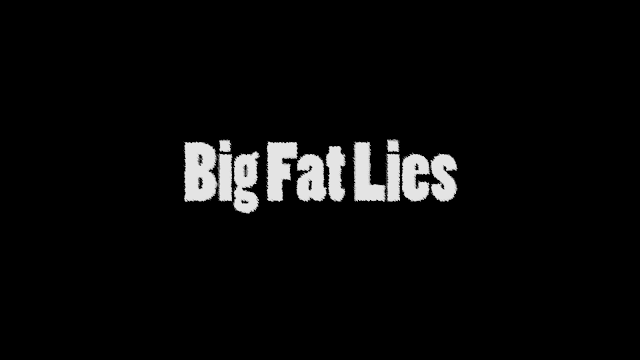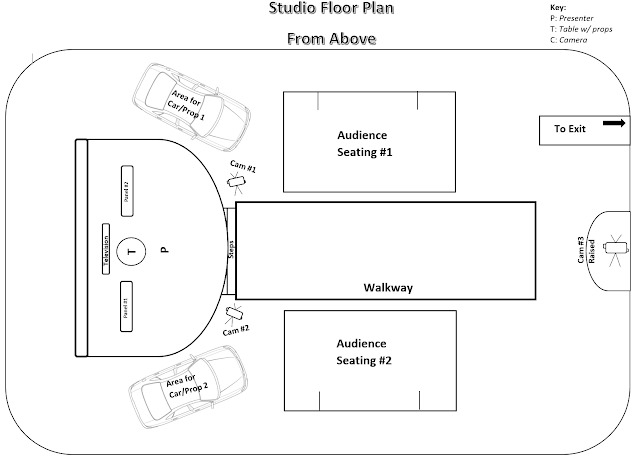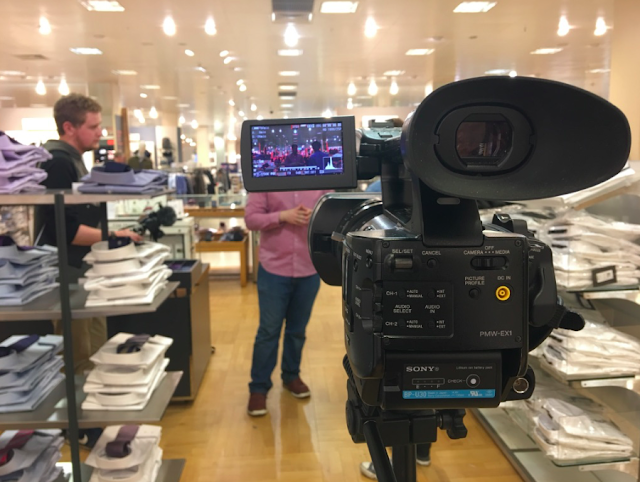Documentary Unit | "Big Fat Lies" - Project Evaluation
Project Evaluation
 The project was ambitious from the get-go, perhaps too much so as we ended up having to cut a fair chunk of material we originally had planned within our script, I feel that as a group we overcome a number of challenges, with each of us taking equal and designated roles within the group throughout all phases of production. This project was the definition of a 'collaborative piece', right down the script being split into 3 separate sections, each of us tailoring the scenes to how we felt would be portrayed best on screen. The script was initially barebones, however over time and various feedback sessions with our unit leader Helen, we were able to produce a cohesive script that could reliably be used for reference throughout all stages of production, whether we be on location or piecing together the timeline within premiere pro. The script was key and acted as the spine of our entire project.
The project was ambitious from the get-go, perhaps too much so as we ended up having to cut a fair chunk of material we originally had planned within our script, I feel that as a group we overcome a number of challenges, with each of us taking equal and designated roles within the group throughout all phases of production. This project was the definition of a 'collaborative piece', right down the script being split into 3 separate sections, each of us tailoring the scenes to how we felt would be portrayed best on screen. The script was initially barebones, however over time and various feedback sessions with our unit leader Helen, we were able to produce a cohesive script that could reliably be used for reference throughout all stages of production, whether we be on location or piecing together the timeline within premiere pro. The script was key and acted as the spine of our entire project.
 In terms of things we'd like to change, I think there are many things we may have done differently had we been given the luxury of an additional week or two, however this was not the case, and for that reason there had to be compromises made. I would like to clarify that the following issues are from my personal opinion and do not necessarily reflect the thoughts of my fellow group members;
In terms of things we'd like to change, I think there are many things we may have done differently had we been given the luxury of an additional week or two, however this was not the case, and for that reason there had to be compromises made. I would like to clarify that the following issues are from my personal opinion and do not necessarily reflect the thoughts of my fellow group members;
Introduction
Over the course of this unit I have learnt a lot about the documentary filmmaking process. From the outset our group, consisting of me, Alex Baldwin and George Nicholls, settled on the idea of a documentary detailing the 'fad diets' and 'fat hacks' that plague our modern, social media driven society.
Whether it be the on location shooting that took place across a wide variety of different areas, or the experience of working closely with a professional actor (our presenter, Andrew Phipps) that we found on CastingCallPro - we were constantly exploring new and interesting ideas, while sticking to the extensive planning we had done in advance, Naturally things didn't go exactly as planned, however we believe that we have done the best to our ability given the resources and time we had to complete this project. I particularly enjoyed the editing phase of production as it really gave me the opportunity to not only flex my own creative energy, but to also collaborate with others on an edit for first time, really emphasising the team mentality we had going into this project.
What Went Well?
 The project was ambitious from the get-go, perhaps too much so as we ended up having to cut a fair chunk of material we originally had planned within our script, I feel that as a group we overcome a number of challenges, with each of us taking equal and designated roles within the group throughout all phases of production. This project was the definition of a 'collaborative piece', right down the script being split into 3 separate sections, each of us tailoring the scenes to how we felt would be portrayed best on screen. The script was initially barebones, however over time and various feedback sessions with our unit leader Helen, we were able to produce a cohesive script that could reliably be used for reference throughout all stages of production, whether we be on location or piecing together the timeline within premiere pro. The script was key and acted as the spine of our entire project.
The project was ambitious from the get-go, perhaps too much so as we ended up having to cut a fair chunk of material we originally had planned within our script, I feel that as a group we overcome a number of challenges, with each of us taking equal and designated roles within the group throughout all phases of production. This project was the definition of a 'collaborative piece', right down the script being split into 3 separate sections, each of us tailoring the scenes to how we felt would be portrayed best on screen. The script was initially barebones, however over time and various feedback sessions with our unit leader Helen, we were able to produce a cohesive script that could reliably be used for reference throughout all stages of production, whether we be on location or piecing together the timeline within premiere pro. The script was key and acted as the spine of our entire project.
Another positive throughout the project was our choice to use multiple cameras to shoot with, at no point during shooting were we armed with less than 2 cameras, and for the large majority of shooting time, we were using 3, ensuring the maximum flexibility during the edit in terms of angles, shots and audio. This was extremely useful to us while piecing together scenes as it allowed us to cut to a slightly differently angled shot in order to mask various insecurities we had about a particular shot or piece of dialogue. Furthermore we also pre-prepared when recording commentary, as due to our conflicting shooting schedule we had to record our commentary slightly before the documentary had wrapped shooting, meaning we had to take the initiative to record various lines of dialogue in advance. I was proud to be able to offer my new Rode NT1 professional microphone up as a tool to use in the development of this documentary, and we all feel that the professionalism can be heard through the quality of the audio used in the final documentary.
What Could We Improve?
 In terms of things we'd like to change, I think there are many things we may have done differently had we been given the luxury of an additional week or two, however this was not the case, and for that reason there had to be compromises made. I would like to clarify that the following issues are from my personal opinion and do not necessarily reflect the thoughts of my fellow group members;
In terms of things we'd like to change, I think there are many things we may have done differently had we been given the luxury of an additional week or two, however this was not the case, and for that reason there had to be compromises made. I would like to clarify that the following issues are from my personal opinion and do not necessarily reflect the thoughts of my fellow group members;
I personally feel that the design we went for when it came to the fact boxes that appear throughout the documentary, as well as the name cards that pop into view at relevant moments, these could have been perfected and made much more aesthetically appealing over time, however this was not a priority when it came down to the final few days of editing. We had reshoots to complete late into the process and due to that editing time being eaten up, there perhaps wasn't enough attention being given to the right areas, however I feel that despite this we have produced and sound and cohesive documentary that tells an interesting story from start to finish, and for what it's worth... I'm immensely proud of what me and the team have accomplished this unit.
Along with this we particularly noticed that there were a couple of shots we had to use in the final cut that included glimpses of one of us, specifically during the John Lewis sequence where Andrew is seen emerging from the fitting rooms adorning various different types of casual wear. This is unfortunately unavoidable due to the nature of these reshoots and is simply one of those things that we have to look back on and avoid doing in the future. Lesson learnt!
Conclusion
We started this project without a real idea of where we were going to go with this, we were offered essentially a clean slate with a vague project brief, that being a documentary in the style of a BBC Three style exposure piece. Giving us the flexibility to play with both comical and serious undertones, while also ensuring we had a definite young adult 15 - 25 year old demographic. I can without a doubt say that this is the most comprehensive and cohesive piece of media I have ever had the pleasure of working on, and I am incredibly happy with the results. I have expanded my knowledge when it comes to both on location production, working hands on with kit in an intense environment and with professional actors, as well as getting a thorough opportunity to stretch my editing expertise in Premiere Pro, collaborating with some of the best people I know. I am immensely grateful for not only the work my teammates have put in, but the bonds we've nurtured over the past two months, while there were of course obstacles on the way to this point, we've come out the other side with something we feel is truly special, and for that reason we genuinely hope you've enjoyed "Big Fat Lies".




Comments
Post a Comment